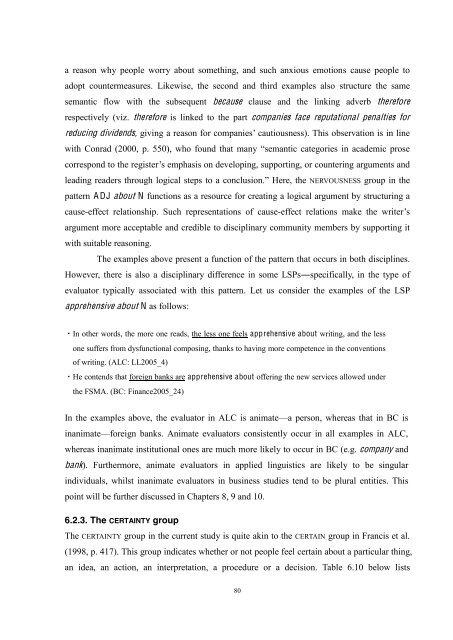Evaluative Meanings and Disciplinary Values - eTheses Repository ...
Evaluative Meanings and Disciplinary Values - eTheses Repository ...
Evaluative Meanings and Disciplinary Values - eTheses Repository ...
You also want an ePaper? Increase the reach of your titles
YUMPU automatically turns print PDFs into web optimized ePapers that Google loves.
a reason why people worry about something, <strong>and</strong> such anxious emotions cause people to<br />
adopt countermeasures. Likewise, the second <strong>and</strong> third examples also structure the same<br />
semantic flow with the subsequent because clause <strong>and</strong> the linking adverb therefore<br />
respectively (viz. therefore is linked to the part companies face reputational penalties for<br />
reducing dividends, giving a reason for companies cautiousness). This observation is in line<br />
with Conrad (2000, p. 550), who found that semantic categories in academic prose<br />
correspond to the registers emphasis on developing, supporting, or countering arguments <strong>and</strong><br />
leading readers through logical steps to a Here, the NERVOUSNESS group in the<br />
pattern A DJ about N functions as a resource for creating a logical argument by structuring a<br />
cause-effect relationship. Such representations of cause-effect relations make the writers<br />
argument more acceptable <strong>and</strong> credible to disciplinary community members by supporting it<br />
with suitable reasoning.<br />
The examples above present a function of the pattern that occurs in both disciplines.<br />
However, there is also a disciplinary difference in some LSPs the type of<br />
evaluator typically associated with this pattern. Let us consider the examples of the LSP<br />
apprehensive about N as follows:<br />
In other words, the more one reads, the less one feels apprehensive about writing, <strong>and</strong> the less<br />
one suffers from dysfunctional composing, thanks to having more competence in the conventions<br />
of writing. (ALC: LL2005_4)<br />
He contends that foreign banks are apprehensive about offering the new services allowed under<br />
the FSMA. (BC: Finance2005_24)<br />
In the examples above, the evaluator in ALC is animatea person, whereas that in BC is<br />
inanimateforeign banks. Animate evaluators consistently occur in all examples in ALC,<br />
whereas inanimate institutional ones are much more likely to occur in BC (e.g. company <strong>and</strong><br />
bank). Furthermore, animate evaluators in applied linguistics are likely to be singular<br />
individuals, whilst inanimate evaluators in business studies tend to be plural entities. This<br />
point will be further discussed in Chapters 8, 9 <strong>and</strong> 10.<br />
6.2.3. The CERTAINTY group<br />
The CERTAINTY group in the current study is quite akin to the CERTAIN group in Francis et al.<br />
(1998, p. 417). This group indicates whether or not people feel certain about a particular thing,<br />
an idea, an action, an interpretation, a procedure or a decision. Table 6.10 below lists<br />
80
















